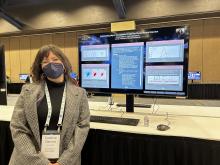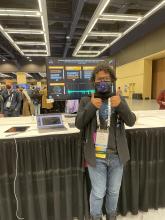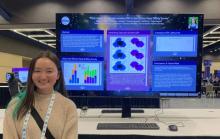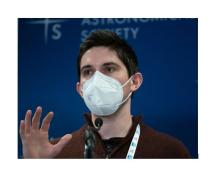The 241st meeting of the American Astronomical Society was a stellar success for UW Astronomy! More than 100 UW-affiliated registrants made an impressive showing on our home turf with press releases, undergraduate iPosters, and sessions packed with UW research. As the AAS and astronomy community at large return to masked, in-person events, new forms of communication and collaboration emerged as key themes of the conference. Read on for a handful of ways that UW Astronomy shone at this winter’s meeting.
UW, darling of the grad fair
At the Grad School & REU Fair on Sunday, Jan. 8, undergraduate students had the opportunity to speak with representatives from a wide range of graduate programs. But no booth was quite as popular as UW Astronomy, as students waited in long lines to speak with Dr. Eric Agol, Dr. Mario Juric, and graduate student Debby Tran.
“There was just a huge, 20-person line when I got there,” said Debby. “It was a lot, but it was really sweet. A lot of people had either been thinking about UW or had already applied and wanted to talk to a grad student or a professor about what it’s like… Grad school can be really challenging; it’s definitely really important to get support where you can, and amongst the grad students here it’s really wonderful.”
Undergrads take AAS241
UW Astronomy undergraduate students represented at the iPoster sessions, highlighting topics from Solar system bodies to the circumgalactic medium. But more than just the science on display, undergrads gained a deeper understanding of how to present their research and navigate the whirlwind of a big conference like AAS.
Third year Yasin Arafi Chowdhury presented his work using the DECam Deep Drilling survey to detect main belt asteroids, showing that though DECam is intended for variable star science, it can also be used to detect objects closer to home. Working with his mentor Dr. Ari Heinze, Yasin cross matched data from the Minor Planet Center to identify nearly 300 known asteroids and discovered new objects yet to be analyzed. He also used optical color filters to investigate asteroid composition variation across the main belt and light curves from the best-imaged asteroids to track their rotation periods. At his first AAS conference, Yasin was happy to connect with researchers from other institutions as well as get to know more of the UW Astronomy community.
Fourth year Catalina Zamora presented work from her summer REU at Green Bank Observatory, corroborating her mentor’s hypothesis that the gas tracer N2H+, found in prestellar cores, has more turbulent motion than NH3 despite its larger mass. In addition to presenting her research, Catalina had the chance to explore grad school options, connecting with potential colleagues despite the growing pains of graduation.
“It was eye-opening for that to be my very first conference in the field,” she said. “Knowing that the community is small enough that I’ll always have these connections is really, really nice. I really like that aspect of the field, just knowing that there’s always that sense of community and collaboration… To know that, going forward, no matter where I go I’ll find something like that.”
Third year Ishan Ghosh-Coutinho presented their work validating the machine learning classifications of evolved massive stars, a process that usually involves photometric observations and extensive telescope time. The classifier, trained by one of their mentors Dr. Trevor Dorn-Wallenstein, sifted through Gaia data to identify cool supergiants and emission line object candidates, which are stars that can host fascinating physical phenomena such as stellar winds or circumstellar disks. Ishan analyzed several of these candidates using spectroscopic observations from Apache Point, focusing on verifying their broad stellar classifications to validate the machine learning classifier. Ishan verified spectral types of several emission line and cool supergiant candidates, notably identifying a new Be star. While presenting at their first AAS meeting, they not only learned new tips on scientific writing but also enjoyed meeting others just as excited to share their work.
Post baccalaureate researcher Midori Rollins presented an overview of early results from the DECam Deep Drilling survey, using faint transients to gain a better understanding of time-variable data within deep drilling fields. Using the SIMBAD database, Midori cross matched known AGN (active galactic nuclei) with light curve data from DECam to demonstrate the survey’s optical variability. Even with data coming in just weeks before the conference, Midori and her mentor Dr. Melissa Graham found that three of the brightest objects they imaged were quasars.
“Because this is my first time getting into research, I thought when people present their stuff… they had a whole set of findings and a concrete conclusion,” she said. “But I learned that you could really just be in the middle of your research and just be presenting what you’re currently working on. You don’t have to be finished.”
Represented by post baccalaureate researcher Thomas Do, fifth year Ally Payne, and fourth year Alexandre Ramirez, the Werk SQuAD (Student Quasar Absorption Diagnosticians) presented their investigation into the relationship between a galaxy’s orientation in the sky relative to a nearby quasar sightline and the measured ion densities in a galaxy’s CGM (circumgalactic medium). Led by Dr. Jessica Werk, the SQuAD performed a spectroscopic analysis on 21 quasar sightlines to probe the shape and dynamics of the gas flows within the CGM. For both Thomas and Ally, presenting their work was a demanding but enjoyable experience and is helping them refine their ongoing survey.
“It’s very valuable because it led to us thinking more deeply about why we’re choosing our sample and the way we’re filtering out any data,” said Thomas. “That’s part of what we’re doing right now is we’re going back, making sure that we can address these questions and use the feedback to improve our analysis.”
“It’s eye-opening to see when people come up to our poster and ask us these questions and point out things that we maybe didn’t consider before. So that was kind of cool, just to get that first-hand, immediate interaction,” said Ally.
UW discoveries in the media
The astronomy department also had a stellar turnout at the press conferences; UW researchers presented their discoveries in three out of the eight total panels.
Dr. Bruce Balick discussed the energetic history of the Butterfly Nebula, especially the violent impacts from its parent star that have shaken typical gas flow patterns within its wings over the last several hundred years. Using Hubble images, Dr. Balick and then-UW undergraduate Lars Borchert compared photos taken 11 years apart to reveal that the star at the center of the nebula is ejecting material in bursts at different angles, giving the system a much more disrupted structure than most other planetary nebulae.
Dr. Balick believes high velocity stellar winds are driving lobes of material into one another, exciting an iron emission line usually only seen in higher energy events. But the star at the center of the Butterfly Nebula is shrouded in dust, rendering his hypothesis that an eccentric third companion is disturbing a central binary untestable.
“As a professional astronomer, the most exciting thing about this is its misbehavior. It doesn't do what we expect it to do,” he said. “[The Butterfly Nebula is] not a bubble. Its wings are a mess, which is completely atypical. Part of what we’re concluding here is this [star] has had a tortured, tempestuous history.”
Dr. Adam Smercina spoke about his research investigating the morphology and resolved stellar populations of the low-mass spiral Triangulum galaxy (M33), finding that while younger stars are spread throughout the galaxy in a typical flocculent pattern, older stars are grouped into a dual-armed, barlike structure, possibly revealing a previously-unknown feature of the evolution of low-mass spiral galaxies.
“We’ve found that if the gas is doing a different thing than what the bulk of the stars are doing, that means the young stars are also going to be doing something different than what the bulk of the stellar mass is doing,” he said. “For galaxies elsewhere in the universe that are a similar mass to M33, that are lower mass spiral galaxies, this may be relevant for how we think about their structure.”
Though this was Dr. Smercina’s first press conference, his approach to communicating with journalists wasn’t much different from his technical talks.
“We forget sometimes that students, or just our peers, are not going to be experts in everything all the time. And so I really try to give a similar level of background and motivation and sort of storytelling as I would giving a talk to the public,” he said.
PhD student Andy Tzanidakis discussed his discovery of a dusty seven-year eclipse, highlighting an unusual type of binary system. Looking for strange stars in Gaia data, Andy and Dr. James Davenport investigated a peculiar object that turned out to be the longest and deepest known blinking star. With the advent of a new “Big Data” era in astronomy, there’s increased motivation to explore weird objects in the massive data streams from Gaia (and soon, LSST).
“We are getting to this point where we have so much data, and it’s getting possible now to start looking at the anomalies and discovering new kinds of stars,” he said. “I stumbled across a star very, very serendipitously and I was like ‘Oh boy, what is this?’ We went down a rabbit hole for like one week and we were like ‘Okay, this is probably nothing,’ but it ended up being something.”
At his first press conference, Andy appreciated the opportunity to engage with reporters and practice different methods of science communication.
“I’d never done anything like this before. It was a very, very cool experience,” he said. “It’s kind of a break from getting into the nitty gritty details of the research, and it really gives you an opportunity to give the bigger picture of the science.”
This article was written by Sarah Kahle. Sarah is a senior at UW studying Journalism and Earth & Space Sciences. Outside of her work with the Astronomy Department, she covers science news for UW’s student newspaper, The Daily.






